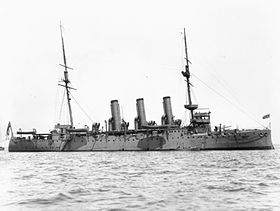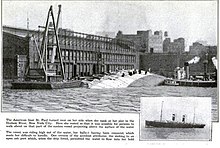HMS Gladiator (1896)
|
|
|
|---|---|
 HMS Gladiator |
|
| Overview | |
| Type | Protected cruiser |
| Shipyard | |
| Keel laying | January 1896 |
| Launch | December 18, 1896 |
| Commissioning | April 1899 |
| Whereabouts | sunk on April 24, 1908 after collision in the Solent, 28 dead; sold for demolition after salvage |
| Technical specifications | |
| displacement |
5,750 ts |
| length |
pp : 97.6 m (320 ft ) |
| width |
17.5 m (57.5 ft) |
| Draft |
6.1 m (20 ft) |
| crew |
480 men |
| drive |
|
| speed |
19 kn |
| Range |
9000 nm at 10 kn |
| Armament |
|
| Armament from 1903/1904 |
|
| Coal supply |
Max. 1200 ts |
|
Armor deck |
|
| Command tower |
228 mm |
| Cannon shields |
114 mm |
The HMS Gladiator was a second class armored cruiser in the Royal Navy . She was the third ship of Arrogant class , which from 1896 to 1899 at the Naval Shipyard in Portsmouth was built. The four cruisers of this class were the first in the Royal Navy to be fully equipped with water-tube boilers . They should be used with the fleet and, if necessary, finally sink disabled ships by ramming them. The HMS Gladiator was lost in a collision in the Solent in April 1908 . The ship was lifted, but scrapped as no longer worth repairing.
Building history
The four Arrogant class cruisers , like the previous Eclipse class, were ordered under the Spencer Naval Program of 1893, which updated the British Naval Act of 1889. They should be used with the fleet and, if necessary, finally sink disabled ships by ramming them. You should therefore get increased maneuverability, which should be achieved by the short length and the installation of two oars. Because of their special task, they were given a reinforced bow with ram stems and a specially armored command post.
A mixed-caliber battery was retained on these cruisers, with four 6-inch L / 40 Armstrong rapid-fire guns now being installed. In addition to the bow gun and the stern gun, there were two guns in front each in casemates, which could participate in the bow and broadside fire. From 1903 the four cruisers were equipped with ten modern 6 inch L / 45 Mk.VII guns instead of the mixed battery of 6 inch and 4.7 inch guns. The light weapons were located between the side battery, in the area of the command posts, in the combat marshes that were initially available and in casemates near the bow and stern.
The four cruisers of the Arrogant class were the first class in which water-tube boilers of the Belleville type were installed on all ships . In three boiler rooms there were six boilers each and three chimneys above them, as on the following protected cruisers of the Highflyer , Challenger and Topaze class .
The keel laying of the HMS Gladiator took place in January 1896 at Portsmouth Dockyard. On December 18, 1896, she was launched as the third ship of the class.
Mission history
The Gladiator entered service in April 1899 as the third ship in the class . Like other cruisers, it was the subject of a dispute about equipping the fleet with water tube boilers, as it also had problems with the new type of boiler.
The Arrogant- class cruisers were used in support of the Royal Navy's battle squadrons. In 1904 the Gladiator was in service with her sister ship Arrogant in the Mediterranean Fleet's liner squadron . In June 1906 she was one of the ships in reserve at Portsmouth .
The collision
The Gladiator sank on April 24, 1908 after colliding with the American liner St. Paul (1895, 11,629 GRT, International Navigation Company ) in the Solent . The cruiser was with a reduced crew of 257 men (instead of 447) on the flyover from Plymouth to Chatham and ran into the Solent in a snowstorm at a visibility of about 700 m. The commander, Captain William Lumsden, incorrectly assessed the evasive maneuver signaled by the Saint Paul sailing out at 13 knots and dodged to the wrong side. Both ships tried to stop. But the cruiser ran through its maneuver of Saint Paul in front of the bow, which hit the cruiser behind the engine rooms and tore a large hole in him. The gladiator almost managed to run onto the beach at Wight near Point Hurst before she capsized to one side and lay there. Although it was only a little over 200 m from the coast, 28 men were killed by the cold water and the strong current. The cruiser could only bring a few boats into the water by tipping over. Several men were rescued from nearby Fort Victoria by helpers of the Royal Engineers .
The recovery
The recovery of the cruiser, lying on its side in the shallow water, proved to be very difficult, especially since the beach in front of Yarmouth is one of the areas most heavily influenced by the tides. The experienced Liverpool Salvage Association managed to lift the cruiser and bring it to Portsmouth by October of that year. It was only with great effort and with the help of divers who had to remove disruptive parts that the lifted ship was brought to a dock. A repair turned out to be no longer useful and the wreck was sold to the Netherlands for demolition. The sale of the wreck did not cover the salvage costs incurred.
responsibility
A naval court reprimanded Captain Lumsden in July 1908, but saw responsibility for the collision with the Saint Paul . Subsequent civil proceedings by the Navy against the owners of the Saint Paul ruled in favor of the owners of the Saint Paul .
Fate of Saint Paul
The Saint Paul had already served as an auxiliary cruiser in the Spanish-American War . On October 27, 1917, it was taken over again by the War Ministry to serve as a troop transport. She made twelve trips between New York and Liverpool . In April 1918 it was taken over by the United States Navy and overhauled in New York. On April 28, she was being towed from the dry dock to her berth when she suddenly capsized in the North River. The accident happened exactly ten years after the collision with the Gladiator . It was erected again on September 11, 1918, but was no longer repaired after the end of the war. In 1919 it was returned to its civilian owners, who no longer used it and sold it to Germany for demolition in 1923.
literature
- RA Burt: British Battleships 1889-1904 , Naval Institute Press, Annapolis, Maryland (1988), ISBN 0-87021-061-0 .
- Roger Chesneau, Eugene M. Kolesnik (Eds.): Conway's All The World's Fighting Ships, 1860-1905 , Conway Maritime Press, London (1979), ISBN 0-85177-133-5
- FJ Dittmar, JJ Colledge: British Warships 1914-1919 , Ian Allen, London (1972), ISBN 0-7110-0380-7
- Paul G. Halpern: A naval history of World War I , Routledge (1995)
- Tony Gibbons: The Complete Encyclopedia of Battleships and Battlecruisers: A Technical Directory of All the World's Capital Ships From 1860 to the Present Day , Salamander Books Ltd., London (1983)
- Randal Gray (Ed.): Conway's All The World's Fighting Ships 1906-1921 , Naval Institute Press, Annapolis, Maryland (1985), ISBN 0-87021-907-3 .
Web links
- Arrogant- class historyofwar
- Arrogant- class in World War1.co
- HMS Gladiator battleships-cruisers.co
Individual evidence
- ↑ Inquiry in the House of Commons about repairs
- ^ Reply of the Admiralty in the House of Commons Discussion as to whether there are enough officers on watch on board
- ↑ IoW Council History of Fort Victoria ( Memento of 21 February 2012 at the Internet Archive )
- ↑ Report on the sinking and salvage of the cruiser ( memento of October 10, 2012 in the Internet Archive ) with pictures


